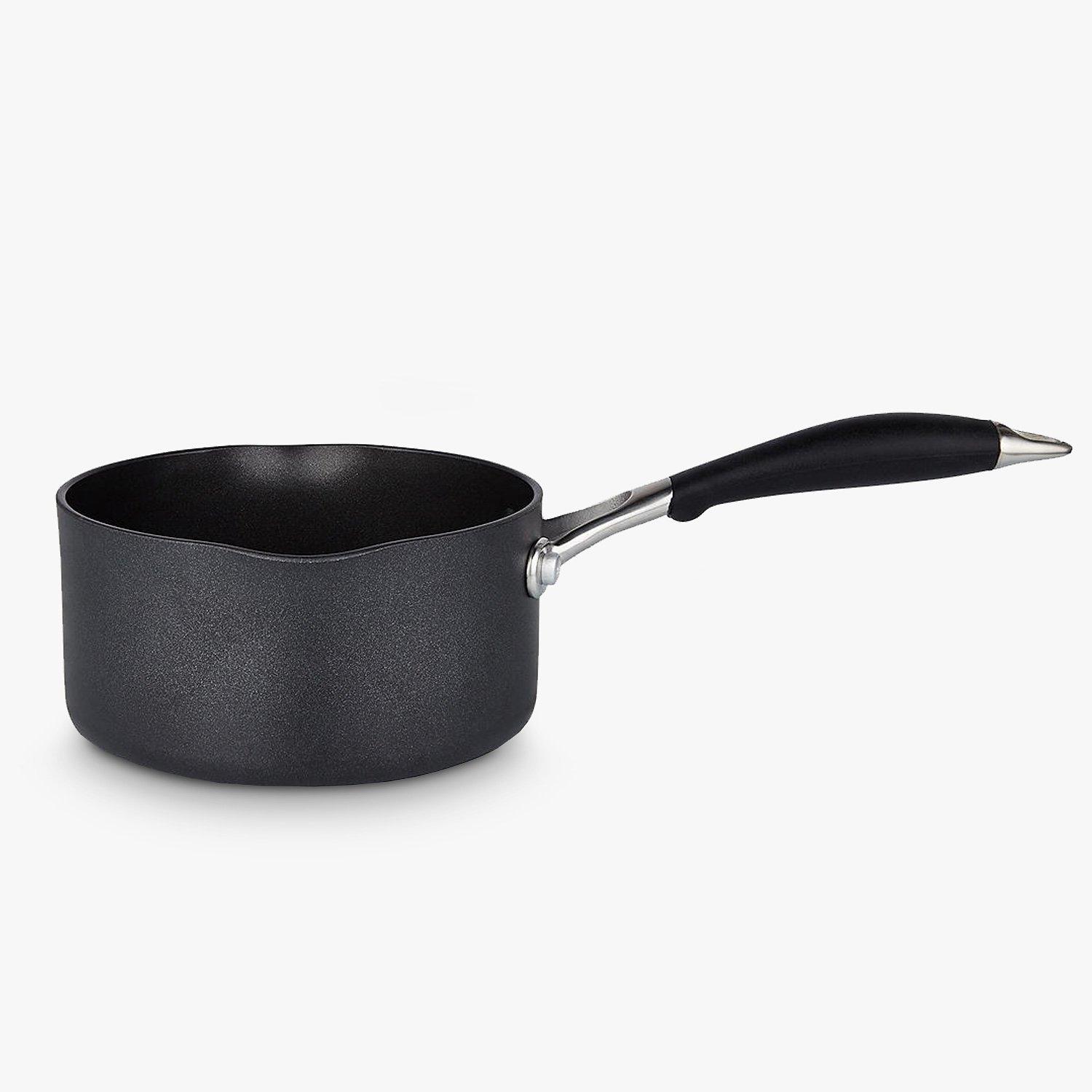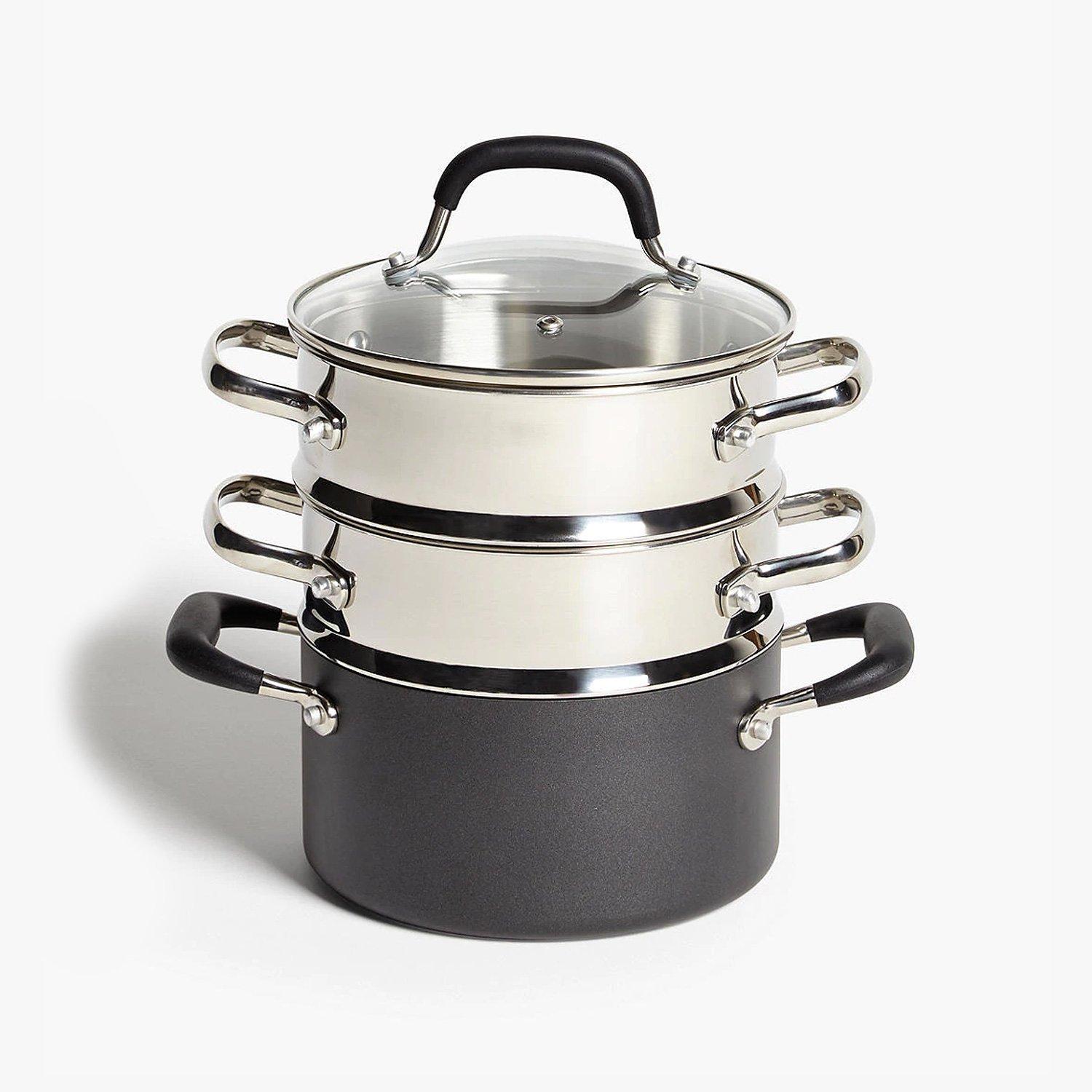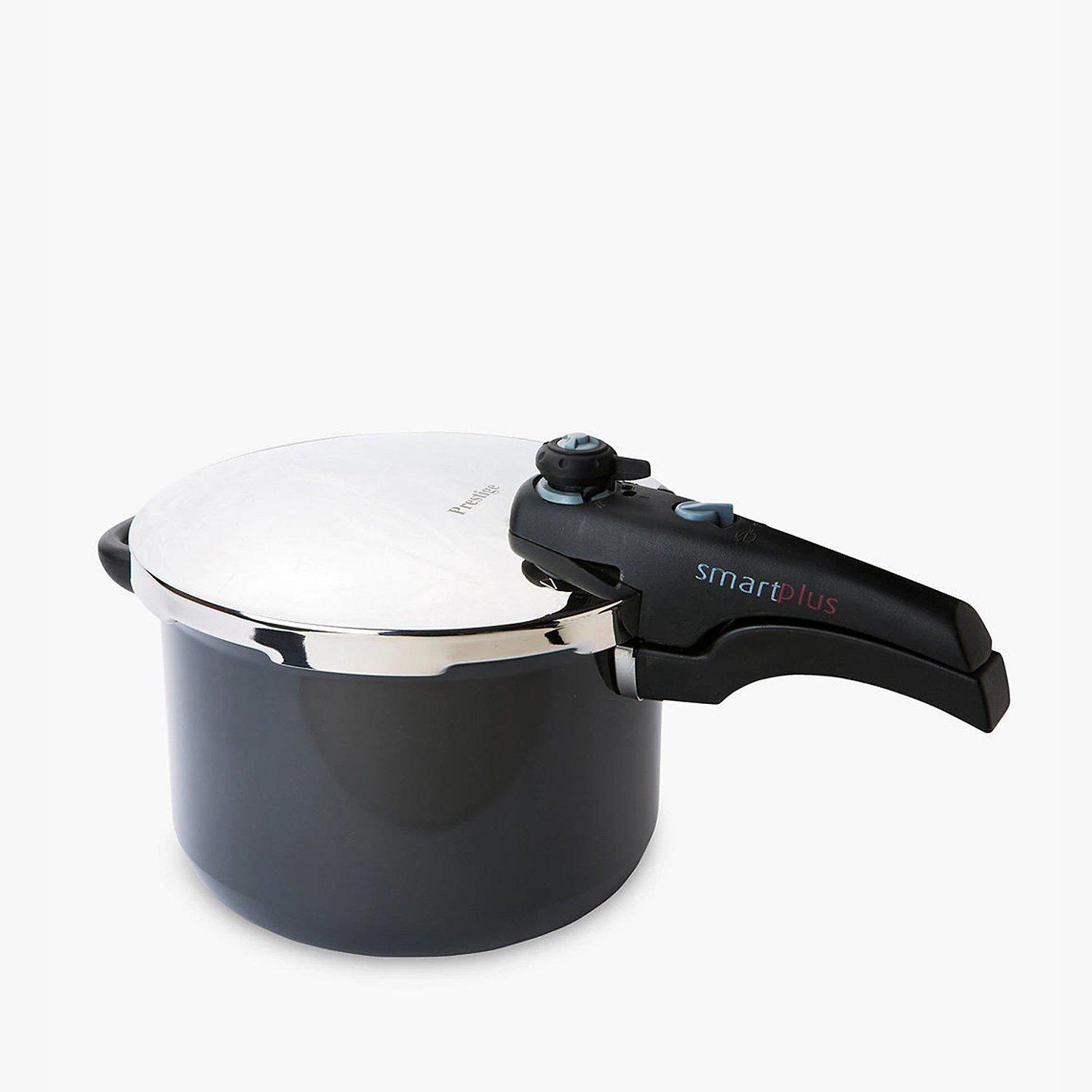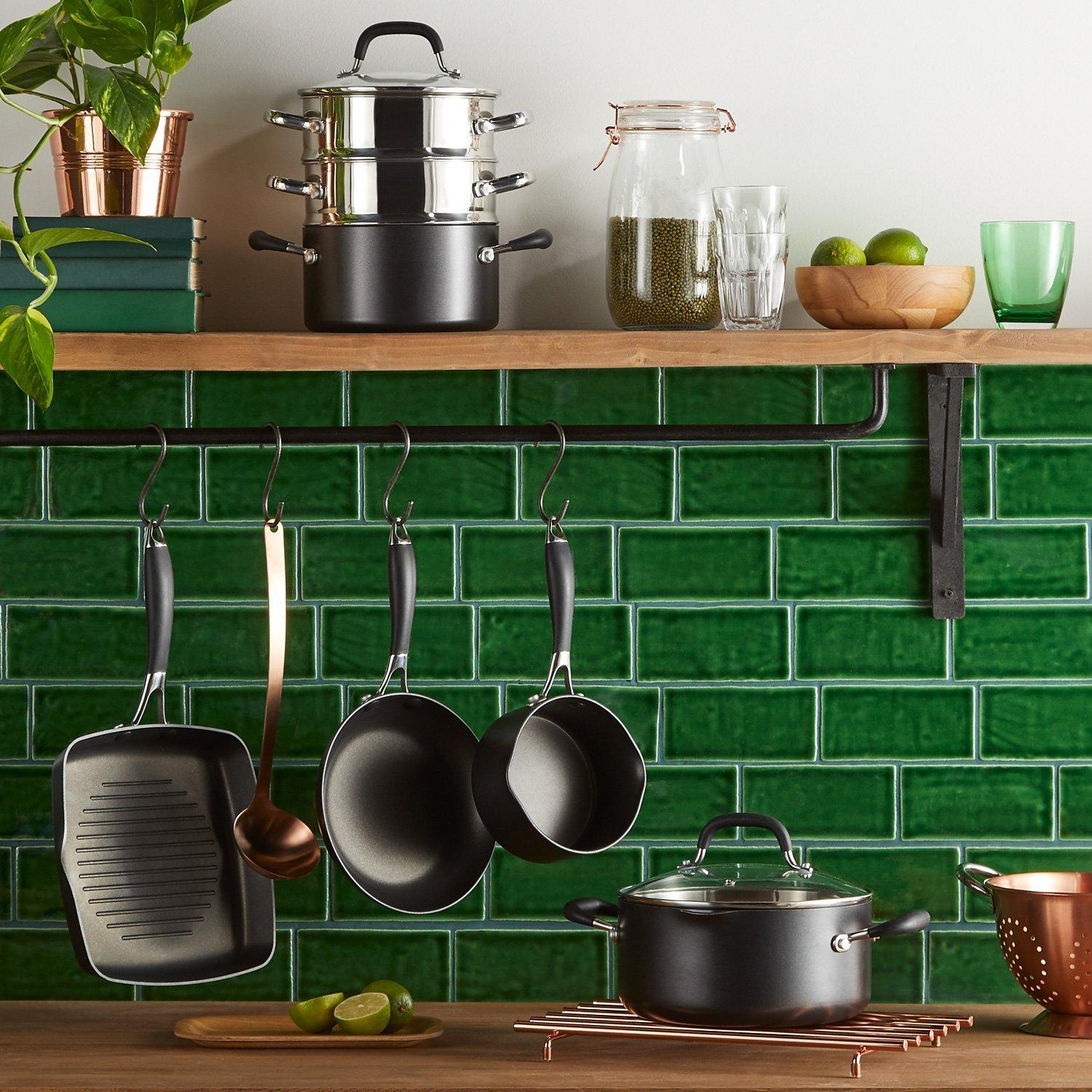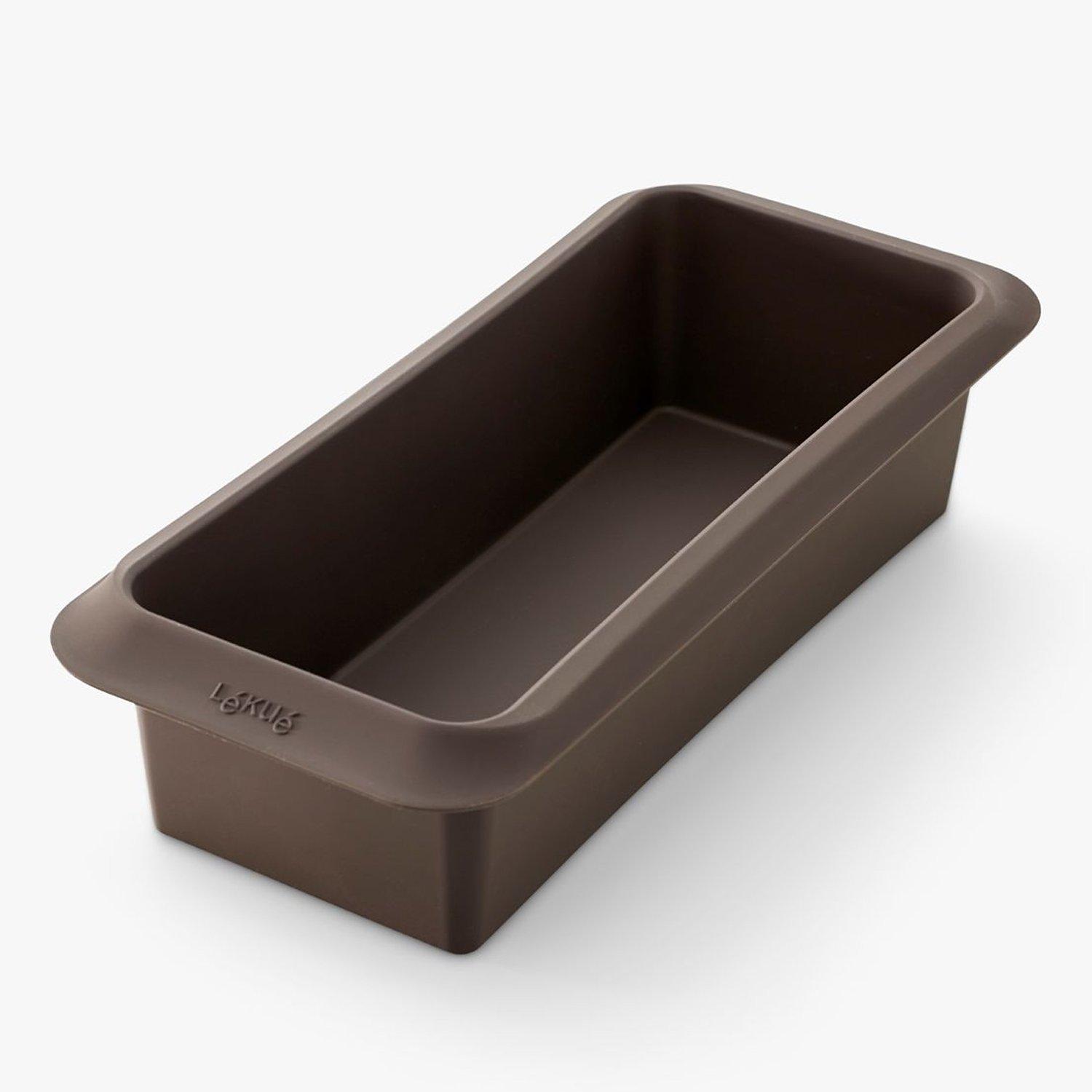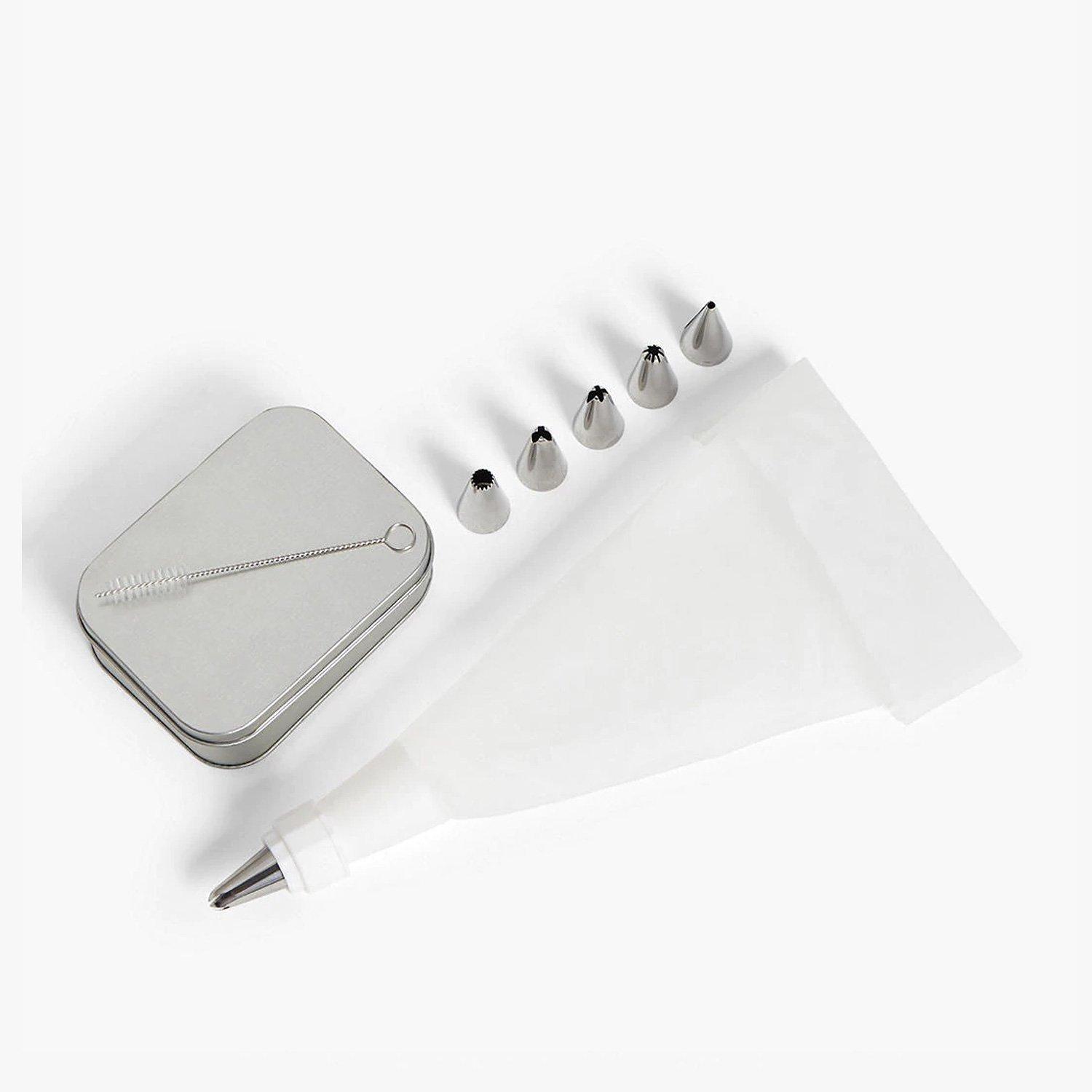Buying & Care Guide
Buying Pots & Pans

Most cookware and bakeware is made to last for years and can be a real investment.
We offer a wide range of styles and price ranges, with something to suit everyone, whether you’re a student living away from home for the first time, equipping a kitchen from scratch, replacing old cookware or upgrading to professional bakeware.
If you'd like advice on small appliances, kitchen knives or preserving, take a look at our food prep buying guide.
Choose the right pots and pans for your hob
Make sure you're buying cookware that's compatible with the hob and heat source you use. All of the hob cookware we sell is compatible with induction hobs. For the best results, here are some tips on using pots and pans for your type of hob.
Gas
You can use any type of pan on a gas hob. Make sure you regulate the flame to prevent it extending beyond the base of the pan, as this wastes gas and can damage pot and pan handles.
Induction
Induction hobs heat by creating magnetic currents directly in the base of your cookware, rather than heating the glass cooker surface like conventional electric hobs. Because the heat is created in the pan itself, heating the pan is very fast, so it is very easy to overheat pans on an induction hob. We recommend using the low-medium heat settings for cooking and avoiding the higher heat settings, as this may cause pans to overheat and become damaged. We advise against using the 'Rapid boil' or 'Boost' functions as this risks damaging your cookware or even the hob itself.
Only pans with a ferrous metal (carbon steel, cast iron and certain types of stainless steel) in the pan base are suitable for induction hobs. Copper and aluminium pans won’t heat up unless they have a ferrous metal base added.
All John Lewis & Partners pots and pans can be used on induction hobs. For the correct functionality of induction pans, it is important to make sure the magnetic circuit with the hob isn’t broken:
- Match the pan size to the cooking area size; each hob zone is designed to magnetically heat a particular range of pan sizes. If you try to use a small pan on a large cooking zone, the pan may not be recognised and the induction won’t switch on
- Use pans with a flat base. Woks with rounded bases won't work
- Don't lift the pan off the hob as it will stop heating
- Ensure the base of your pan is clean before placing on an induction hob, as residue and carbon deposits may cause scratches to the glass top
Solid hotplate
Solid hotplates are usually made from cast iron and have a sealed electric element inside. Use a pan with a flat base to ensure even heating without wasting energy.
Ceramic
An electric hob made from ceramic glass with a heating element underneath. Remember to always lift pans off the surface and not slide them to avoid damage.
Halogen
Heat comes from halogen lamps under a glass hob, which efficiently transmit heat and light upwards. Use pans with thick bases, as they can withstand short bursts of intense heat. Avoid very shiny bases as they can reflect the light, causing the lamps to switch off.
Solid fuel
Solid fuel is used with cookers such as Agas, which often generate hot water to heat the house as well as cook. Choose pans and trays with thick bases that can withstand high temperatures.
Types of cookware
Depending on what you're cooking and how you cook it, you'll need the right pot or pan for the job. Whether it's a go-to saucepan, a milk pan for sauces, a wok for stir-fries or a griddle pan for searing, here's a taste of different types of cookware.
Saucepans
- Versatile kitchen staple for boiling water, heating up food and making sauces and soups
- Usually sold with lids for faster boiling and for slower cooking at lower temperatures to retain moisture
- Some lids have air vents to let off steam, prevent the pan from boiling over and to stop the lid from rattling, although vents let moisture escape
- Typically have a long single handle. Larger sizes may have a short helper handle for easier lifting
- Saucepans with straight sides carry more volume
- Sloped sides and non-stick surfaces are an advantage when making sauces
Frying pans
- Kitchen essential for frying, searing and browning food at medium to high heat
- Shallow, flared sides with a flat base
- Also known as a skillet
- Typically have a non-stick coating
- Do not come with a lid
- Typically have a long single handle. Larger sizes may have a short helper handle for easier lifting
Saute pans
- Versatile pan for making sauces, braising, poaching and shallow frying
- Wide and shallow design is ideal for reducing sauces
- Usually sold with lids to retain moisture for slower cooking on the hob or in the oven
- Ideal for searing and browning food with the lid off and then adding the lid for slow, tender cooking
- Typically have a long single handle. Larger sizes may have a short helper handle for easier lifting. Oven-safe pans usually have two shorter handles
- Pans with straight sides carry more volume. Versatile chef’s pans have sloping sides for stir-frying
- Sloped sides and non-stick surfaces are an advantage when making sauces
Woks & stir fry pans
- Deep and rounded for stir-frying and browning chopped food quickly to retain crunchiness
- Most woks can also be used for deep-frying, poaching and toasting
- Usually sold without lids. Woks with lids can be used for steaming and slower cooking once food has been seared
- Typically have a long single handle. Larger sizes may have a short helper handle for easier lifting. Some have two short handles for oven use
- Uncoated carbon steel and iron woks can take higher temperatures and are more durable
- Non-stick coated woks are lower maintenance
- Most require seasoning or conditioning before the first use and regular care
Stock pots
- Sold with lids to retain moisture for slow cooking which tenderises meat
- Have short handles for oven cooking
- Most can be used on the hob for browning food first
- Pans with straight sides carry more volume
- Sloped sides and non-stick surfaces are an advantage when making sauces
- Wider pots for stewing are usually called casseroles
- Taller pots are ideal for making soups and stocks
Pressure cookers
- Fast, airtight way to tenderise food and retain flavour through steam pressure
- Keeps food moist so ideal for stews
- Stovetop ones are often cheaper and more compact
- Stovetop models can be used for browning but need to be monitored
- Electric ones are less noisy and can be put on a timer and left
- Electric models are more versatile and accessories such as steamer baskets are often available
Cookware & bakeware materials
Whether you need lightweight aluminium, traditional cast iron, durable carbon steel or classic stainless steel pots and pans, we offer a wide range of the best cookware materials, each with their own benefits.
Aluminium
- Aluminium is lightweight and heats quickly and evenly
- All the aluminium cookware sold at John Lewis has a PFOA-free non-stick coating for ease of cooking and cleaning
- Aluminium is not naturally induction compatible, so we add a ferrous metal layer in the base to ensure induction compatibility on all of our cookware
Stainless steel
- Stainless steel is hard-wearing and long-lasting
- For improved heat conductivity we layer aluminium in the base of each pan
- Our pans are made using 18/10 Stainless Steel containing Chromium and Nickel which provide corrosion resistance, hardness and shine
- Our 5-Ply Thermacore range is made with 3 layers of aluminium, enclosed by 2 layers of stainless steel. The layers extend up the full height of the sides which improves performance
- Stainless steel is not naturally induction compatible so we add a ferrous metal layer to ensure induction capability on all our cookware
Cast iron
- Cast iron is a versatile material with moderate heat conductivity
- Enameled cast iron is excellent for low and slow cooking, and non-enamled cast iron for high temperature searing
- Most cast iron pans have an enamelled exterior and either an enamel or non-stick interior
- The material retains heat, making it ideal for oven-to-table serving
- Cast iron is incredibly durable and if cared for properly can last a lifetime
- Non-enameled cast iron is not corrosion resistant and will rust if left wet or damp
Hard anodised aluminium
- Hard-anodised aluminium is where a surface layer is hardened by an electro-chemical process to make it tough and durable
- Lightweight yet tougher than stainless steel
- Resistant to chipping, peeling, abrasion and corrosion
- Impervious to chemical reactions with food, even with acidic foods such as tomatoes and citrus fruits
- Excellent for even heat distribution
Carbon steel
- Carbon steel is popular for cookware and bakeware as it heats quickly and cooks evenly
- All carbon steel bakeware sold at John Lewis has a PFOA-free non-stick coating for ease of cooking and cleaning
- Due to its fast heating and durable properties, uncoated carbon steel is a material used for traditional woks
- Uncoated carbon steel needs to be prepared (known as seasoning) before first use, and periodically after that (please use instructions in the caring for your pots & pans section)
- Uncoated carbon steel must be dried after use to prevennt the risk of corrosion on the surface of the pan. Even coated carbon steel can rust if the coating is scratched or chipped, so we advise that only non-metal utensils are used during cooking
Glass
Ceramic
Choosing your Cookware Coating
The type of coating your cookware has will impact how food cooks, what foods you can cook with it and how you should care for it
Non-stick
All our non-stick coatings used on John Lewis Own Brand products do not contain PFOA.
Non-stick coatings can be damaged by scratching, scraping or peeling if the incorrect utensil is used. You should only use plastic, silicone or wood utensils.
Ceramic
Ceramic coatings are an alternative to non-stick coatings. The same care needs to be taken to maintain the properties of a ceramic coating. You should only use plastic, silicone rubber or wooden utensils.
We recommend using a little oil or butter when cooking with ceramic-coated cookware. Refer to the cooking oils section below.
Enamel
Enamel coatings are a glass-based vitreous layer applied to the surface of the product. This is an excellent surface which is resistant to all types of food, relatively non-stick and easy to clean. If used and maintained properly, enamel-coated cookware is very long-lasting.
John Lewis Cookware ranges
We offer a variety of John Lewis cookware ranges, including traditional cast iron, classic stainless steel and contemporary hard anodised, along with lightweight and non-stick options. All of our cookware is suitable for use on induction hobs.
John Lewis Classic
Cookware
For over 30 years we have been offering this reliable range, with the largest assortment of products, for all your cooking needs.
Our Classic range is made of stainless steel, which is magnetic and good at conducting heat. We use 18/10 as this grade of stainless steel is corrosion resistant due to the presence of chromium and nickel. All of our pans have a stainless steel base as this provides the magnetism to use on an induction hob.
- Premium-grade 18/10 stainless steel heats quickly and evenly
- Stay-cool handle design
- Saucepans with lids, built-in lid rests and stepped rims to prevent drips
- Non-stick milk pan and frying pans
- Dishwasher safe and oven safe to 180°C
- Suitable for use on all hobs, including induction
John Lewis ANYDAY Aluminium
Non-Stick Cookware
Our aluminium non-stick cookware is an excellent-value starter range, made with a lightweight aluminium construction and soft-grip Bakelite handles for safe and easy cooking.
Aluminium is not naturally induction compatible, so we add a stainless steel base plate ensuring induction compatibility on all of our cookware.
- Durable, lightweight aluminium frying pan
- Great heat distribution
- Soft-grip Bakelite handles
- Non-stick interior but avoid using metal utensils
- Suitable for use on all hobs, including induction
John Lewis 'The Pan' Aluminium
Cookware
‘The Pan’ Aluminium is our bestselling range, with a lightweight aluminium construction and soft-grip handles for safe and easy cooking.
Lightweight and easy to clean, aluminium is not naturally induction compatible, so we add a stainless steel base plate to ensuring induction compatibility on all of our cookware.
- Durable, lightweight aluminium
- Soft-feel handles
- Dishwasher safe but hand wash recommended
- Glass lids with steam vents
- Non-stick interior but avoid using metal utensils
- Suitable for use on all hobs, including induction
John Lewis 'The Pan'
Stainless Steel Cookware
‘The Pan’ Stainless Steel is our great-value range made with durable 18/10 stainless steel.
Stainless steel is magnetic and good at conducting heat. We use 18/10 as this grade of stainless steel is corrosion resistant due to the presence of chromium and nickel. All of our pans have a stainless steel base as this provides the magnetism to use on an induction hob.
- Durable stainless steel
- Heat-resistant silicone handles riveted for strength
- Dishwasher safe and oven safe to 180°C
- Non-stick milk pan and frying pans
- Glass pour and strain lids
- Suitable for use on all hobs, including induction
John Lewis 5-Ply Thermacore
Cookware
Our professional-quality 5-ply Thermacore range is designed to last, with a multi-layer construction to heat quickly and evenly.
Stainless steel is magnetic and good at conducting heat. We use 18/10 as this grade of stainless steel is corrosion resistant due to the presence of chromium and nickel. All of our pans have a stainless steel base as this provides the magnetism to use on an induction hob.
- Professional quality
- 5-layer construction for quick and even heating
- Handles riveted for strength
- Dishwasher safe and oven safe to 200°C
- Suitable for use on all hobs, including induction
John Lewis Cast Iron
Cookware
Stylish and contemporary, our Cast Iron cookware delivers all the benefits of cooking in traditional cast iron. It's robust and excellent at retaining heat to save energy when cooking.
- Robust, heat-retaining cast iron
- Durable porcelain enamel exterior
- Easy-clean interior prevents sticking and burning
- Easy to hold handles for oven-to-table serving
- Suitable for use on all hobs, including induction
Types of baking tins and trays
A collection of essential tins, trays and moulds gives bakers a great foundation to work with.

Cake tins
- A sandwich tin has shallow sides good for layered cakes such as Victoria sponges, while deep cake tins are ideal for heavy fruit cakes as they allow the cake to rise fully and cook through
- A springform cake tin has a solid base and removable sides that can be unclipped, making it a great option for cheesecakes
Baking Essentials
Baking like a professional requires precision and we have the right baking accessories and essential tools for every step, from dough and pastry prep, to measuring, timing and adding the finishing touches.
Decorating accessories
Create beautifully finished baked creations with cake decorating tools. We have icing smoothers and buttercream scrapers, along with icing bags with piping nozzles for a flawless finish. Add colourful candles and decorative toppers, then choose a stand to display your cakes. Need a gift for the baker in your life? Try our range of novelty cookie cutters.
measuring cups & spoons
Follow recipes to a tee with measuring cups and spoons to scoop up ingredients ready for your mixing bowl. Nesting designs save storage space in your baking cupboard or drawer, and spoons are kept neatly together on rings. Choose a colour to match your kitchen or opt for stainless steel for a professional feel.
How to clean and care for your cookware & bakeware
Please read the instructions supplied with your cookware. Incorrect use may cause damage to your product and impacts performance and appearance.
To ensure your cookware and bakeware last, we recommend caring for them with these tips in mind, including proper cleaning and induction use.
Before using a pan for the first time, remove all packaging and wash the cookware in hot water with a mild detergent, rinse and dry thoroughly.
Making your non-stick pans last
- Don't overheat non-stick pans as it can cause food to stick and/or cause the coating to peel. This is especially important when using non-stick woks which cannot take high heat like a carbon steel wok without a non-stick coating. Only use a medium or low heat, heating gradually and evenly
- For ovenware, to increase the longevity of the non-stick performance, using a moderate heat is advised, between 175°C and 190°C (350°F - 375°F), gas mark 4. This will increase the cooking time slightly but will prevent the food from burning, keeping the moisture and nutrients within while using less fat
- Non-stick is easy to clean by hand so avoid the dishwasher
- Only use wooden or silicone utensils. Metal utensils can scratch non-stick surfaces
- Don't hit the rim of pans with utensils
- Use a pan separator when stacking and storing your pans to protect non-stick surfaces
Heating up pots and pans
- Make sure pans are either the same size or slightly larger than the hob ring, gas flame or heating area. If the pan is too small, this wastes heat, overheats the pan and may damage the handle
- Don't put an empty pan on a hot burner or in a heated oven. This wastes energy and may damage the pan
- Metal pan handles heat up when cooking so be careful when lifting pans and touching handles. Use an oven glove, mitt or pot holder when handling hot pans. On some pans the handle is screwed to the pan. Over time, with repeated heating and cooling, the screw handles may loosen. This is not a manufacturing fault and the handles should simply be tightened using an appropriate screwdriver
- Never heat an empty pan or allow the cookware to boil dry. If overheating does occur, allow the pan to cool slowly before cleaning. This will avoid thermal shock and potential damage to the pan. Do not cool with water
- Many of our pans are suitable for use in the oven. Refer to the product packaging and specifications to check the maximum oven temperature for your product
Care and use of woks
- Heat your wok over a high heat holding the handle, turning and tilting it up to the rim and back, until the metal turns a dark grey/blue colour all round
- Remove the wok from the heat and allow it to cool down
- Dip a thick pad of kitchen towel into 1 ½ tsp of vegetable oil
- Spread the oil so the whole inside surface of the wok is covered in a thin film of oil. Take precautions such as protective gloves, kitchen tongs or chopsticks when coating with oil as the surface will be hot
- Turn on your cooker hood extractor. Return the wok to a medium to low heat for about ten minutes until it starts to smoke
- Once all the smoke disappears and the wok is dark grey or black in colour, it's ready to use
- To preserve the pan, it's recommended to hand wash it in warm soapy water once it has cooled completely. Dry immediately and thoroughly to prevent rusting
Using cooking oils
- Choosing an appropriate oil for your cooking is important for the longevity of your cookware. Every oil has a smoke point, the temperature at which the oil starts to chemically break down. All olive oils have a low smoke point, and virgin or extra virgin olive oils have an even lower smoke point than blended/light olive oils
- We advise against using olive oil for cooking wherever possible, as the breakdown products can burn onto the surface of the pan, resulting in brown colouration
- We advise against using spray oils, as they contain an emulsifier which can easily burn and contaminate the surface of your pans. On uncoated pans this burnt residue is difficult or impossible to clean; on non-stick pans, the effectiveness of the coating will be damaged. Damage of this type is not covered by guarantees
- For best results, we recommend cooking with good-quality refined vegetable oil, rape-seed oil or refined sunflower oil
Cleaning and storing your cookware
- The majority of our cookware is dishwasher safe, which means that the cookware can be washed in a dishwasher occasionally. It does not mean that frequent and constant washing in a dishwasher is desirable. In particular, non-stick coatings will eventually be affected by washing in a dishwasher, and any scratches or chips in coated cookware will expose the underlying material to damage. Where the underlying material is carbon steel or aluminium, deterioration at points of damage will be rapid
- To protect the performance and look of your product, we always recommend handwashing in warm soapy water. Allow the cookware to cool slowly and completely before washing. A hot pan plunged in cold water can result in a thermal shock and eventually deform the pan. After washing, dry the pan immediately
- For stubborn food stains, soak the affected area in warm soapy water, but do not leave the whole piece submerged
- For burnt food that isn't easily removed, fill the pan with water, and add a couple of tablespoons of detergent. Heat up the contents to a gentle boil. Use a plastic or wooden spoon to gently and carefully scrape the food from the surface. Allow to cool slowly and then wash the pan as normal
- Do not use wire wool, brillo pads or nylon scourers to clean any cookware
- If pans are stacked for storage, use a pan protector between the pans to prevent scratching your cookware surfaces
Guarantees
- We’ve designed our pots and pans to be tough, reliable and long-lasting. That’s why all of our John Lewis & Partners cookware ranges come with a guarantee against faulty workmanship and materials for the pan body, handle, knobs, lids and fixings. The length of the guarantee is stated on the packaging and will vary depending on the cookware range
- The guarantee does not apply to normal wear and tear, commercial use, misuse, stains, discolourations or scratches due to overheating and consequential damage
- In the case of a set of products, only the faulty item will be replaced. The guarantee does not cover defects occurring from incorrect care or use as described in this guide. Proof of purchase will be required


